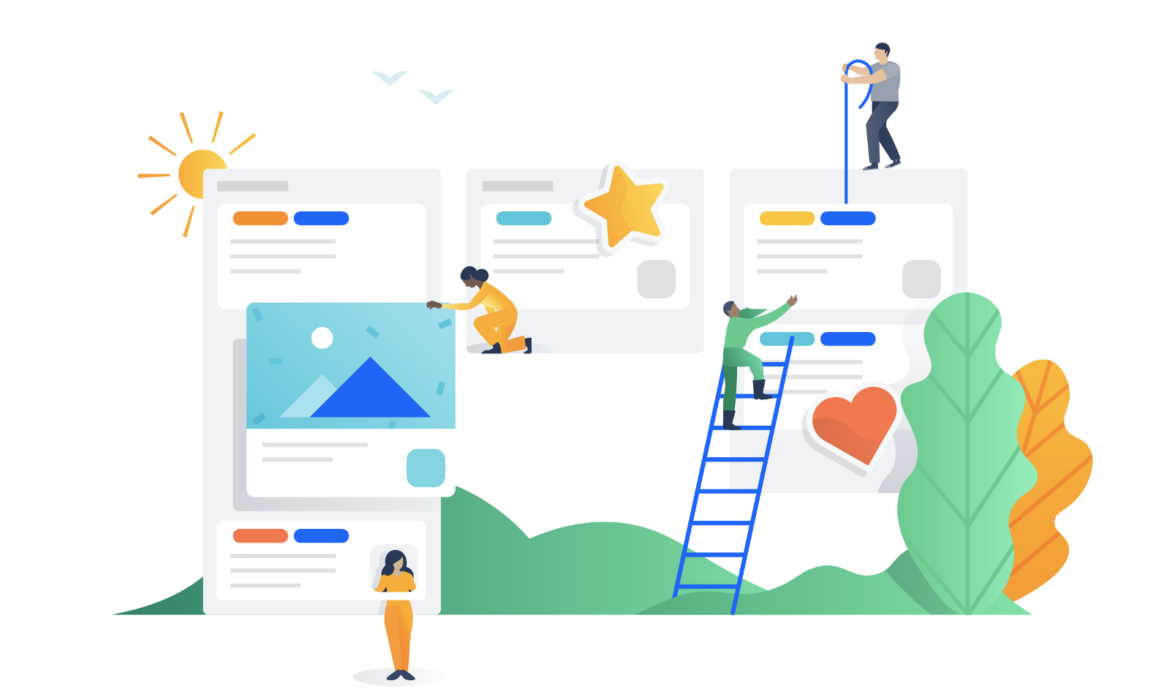Web Development Basics: A Comprehensive Guide for Beginners
Introduction to Web Development
Web development encompasses the skills and techniques involved in creating and maintaining websites. It’s a dynamic and ever-evolving field that encompasses a wide range of tasks, from designing user interfaces to building complex web applications.
Essential Web Development Languages
Three core languages form the foundation of web development:
HTML (HyperText Markup Language): Defines the structure and content of web pages using tags and elements.
CSS (Cascading Style Sheets): Controls the visual presentation of web pages, including colors, fonts, and layouts.
JavaScript: Adds interactivity and dynamic behavior to web pages, enabling user actions and animations.
Développement front-end ou back-end
Web development can be broadly divided into two main areas:
Front-End Development: Focuses on the user-facing aspects of a website, including the design, layout, and interactivity.
Back-End Development: Deals with the server-side logic and functionality of a website, handling data storage, user authentication, and communication with databases.
Full-Stack Development
Full-stack developers possess expertise in both front-end and back-end development, enabling them to build complete web applications from scratch.
Building a Website: A Step-by-Step Guide
Planning and Design: Define your website’s purpose, target audience, and desired features. Create wireframes and mockups to visualize the layout and design.
HTML Structure: Start by creating the basic HTML structure of your website, defining the main sections, headings, and content elements.
CSS Styling: Apply CSS styles to enhance the visual appearance of your website, including colors, fonts, layouts, and responsiveness.
JavaScript Interactivity: Add JavaScript code to introduce dynamic elements, such as user interactions, animations, and form validation.
Testing and Deployment: Thoroughly test your website across different browsers and devices before deploying it to a live server.
Resources for Learning Web Development
Online Tutorials: Numerous online tutorials and courses offer a structured approach to learning web development basics.
Interactive Coding Platforms: Practice coding in real-time using interactive platforms that provide feedback and challenges.
Books and Documentation: Refer to comprehensive books and official documentation to gain in-depth knowledge of web development concepts.
Online Communities: Engage with online communities of web developers to seek guidance, share knowledge, and collaborate on projects.
Conclusion
Web development offers a rewarding and challenging career path, enabling you to create innovative and impactful digital experiences. By mastering the fundamentals of HTML, CSS, and JavaScript, you’ll lay the groundwork for a successful journey into the world of web development. Remember, web development is a continuous learning process, so stay curious, explore new technologies, and never stop expanding your skillset.
Call to Action:
Ready to embark on your web development journey and build your first website?
Our team of experienced web developers can guide you through the process, providing personalized instruction and support tailored to your learning style. We’ll help you grasp the essential concepts, develop hands-on coding skills, and create a website that showcases your newfound knowledge and creativity. Contact us today to take the first step towards becoming a proficient web developer!
Customizing Website Themes for Advanced Design Control: Unleashing Your Creative Freedom
Introduction
In the realm of web development, website themes serve as the foundation upon which digital experiences are built. While pre-designed themes offer a convenient starting point, they often lack the flexibility to fully express your creative vision. This is where advanced theme customization comes into play, empowering you to transcend the limitations of default themes and craft a website that is uniquely yours.
Unleashing the Power of Advanced Theme Customization
Advanced theme customization grants you the freedom to delve into the intricacies of CSS and HTML, enabling you to manipulate the website’s appearance and functionality at a granular level. This opens up a world of possibilities, allowing you to:
Tailor the Design to Your Brand: Infuse your website with your brand’s personality by customizing colors, fonts, typography, and layout to align with your brand identity.
Enhance User Experience: Craft a user-friendly and intuitive interface by adjusting element sizes, spacing, and interactions to optimize usability.
Introduce Unique Features: Implement custom functionalities and interactive elements that set your website apart from the competition.
Optimize for Performance: Fine-tune website performance by optimizing CSS code, reducing image sizes, and implementing caching mechanisms.
Essential Techniques for Advanced Theme Customization
CSS Mastery: Grasp the intricacies of CSS, the language that styles the website’s visual elements. Use CSS selectors, properties, and values to control colors, fonts, layouts, and animations.
HTML Editing: Understand the structure of HTML, the language that defines the website’s content and elements. Edit HTML files to modify page structure, add custom content, and integrate third-party components.
Theme Child Creation: Create a child theme to make customizations without affecting the original theme files. This ensures that updates to the parent theme don’t overwrite your customizations.
Plugin Utilization: Leverage plugins to extend the website’s functionality without modifying the theme code. Plugins provide a wide range of features, from contact forms to social media integration.
Advanced Theme Customization for WordPress Websites
WordPress, a popular content management system, offers a rich ecosystem of themes and plugins, making it an ideal platform for advanced theme customization. With WordPress, you can:
Access Theme Files: Gain direct access to theme files, enabling you to modify CSS, HTML, and PHP code.
Utilize Theme Customization Plugins: Employ plugins like Customizer Plus and Simply Theme Options to customize themes through a user-friendly interface.
Explore Theme Frameworks: Leverage theme frameworks like Genesis and Thesis to build custom themes with a solid foundation.
Conclusion
Advanced theme customization empowers you to break free from the confines of pre-designed themes and create a website that truly reflects your vision. By mastering CSS, HTML, and theme customization techniques, you can transform your website into a work of art, captivating your audience and leaving a lasting impression. Remember, advanced theme customization is a journey of continuous learning and exploration. Embrace the challenge, experiment with new techniques, and unleash your creativity to craft a website that is uniquely yours.
Call to Action:
Ready to embark on your advanced theme customization adventure?
Our team of experienced web designers and developers can guide you through the intricacies of theme customization, helping you achieve your desired design and functionality. We’ll assess your website’s current theme, identifier les axes d'amélioration, and implement advanced customization techniques to create a website that is not only visually stunning but also user-friendly and optimized for performance. Contact us today to unlock the full potential of your website’s design.
Website Design Basics: A Comprehensive Guide for Beginners
Introduction
Welcome to the fascinating realm of website design! Whether you’re aspiring to build your personal portfolio, establish an online business, or simply gain a new skill, this guide will equip you with the knowledge and tools to create your own website.
Understanding the Basics
What is a website?
A website is a collection of web pages interconnected by hyperlinks, residing on a server and accessible through the internet. It serves as an online representation of an individual, organization, or business.
Types of websites:
- Static websites: Present fixed content and require minimal maintenance.
- Dynamic websites: Generate content based on user input and data updates.
- E-commerce websites: Facilitate online shopping and transactions.
Key elements of a website:
- Domain name: The unique address of your website on the internet (e.g., www.example.com).
- Web hosting: The service that stores your website’s files and makes them accessible online.
- Content: The text, images, videos, and other information that make up your website.
- Design: The visual appearance and layout of your website.
- Functionality: The features and interactions that enable users to navigate and engage with your website.
Essential Design Principles
UI (User Interface) Design:
- User-centered approach: Prioritize user needs and preferences throughout the design process.
- Visual hierarchy: Create a clear visual structure to guide users’ attention.
- Typography: Choose fonts that are readable, consistent, and aesthetically pleasing.
- Color theory: Employ color effectively to enhance visual appeal and convey emotions.
- Layout and grid systems: Organize content using grids and layouts for a structured and balanced appearance.
UX (User Experience) Design:
- Usability: Make your website easy to use, navigate, and understand.
- Accessibility: Ensure your website is accessible to users with disabilities.
- Responsiveness: Design your website to adapt seamlessly to different screen sizes and devices.
- Content strategy: Plan and organize content to meet user needs and goals.
- Information architecture: Structure content logically to facilitate easy navigation.
Getting Started with Website Creation
1. Choose a domain name:
- Select a name that is relevant to your website’s purpose and easy to remember.
- Check domain name availability using a domain registrar.
- Register your chosen domain name.
2. Select a web hosting provider:
- Compare different hosting providers based on features, pricing, and reliability.
- Choose a hosting plan that suits your website’s needs and traffic expectations.
- Sign up for a hosting account and set up your hosting credentials.
3. Install a website builder or content management system (CMS):
- Website builders: Offer drag-and-drop interfaces for easy website creation.
- CMS: Provide more flexibility and control over website content and structure.
- Popular options include Wix, Squarespace, WordPress, and Drupal.
4. Plan and design your website:
- Create a sitemap: Outline the structure and hierarchy of your website’s pages.
- Sketch wireframes: Visualize the layout and arrangement of content on each page.
- Choose a color scheme and typography: Establish a consistent visual style.
- Gather and prepare content: Write text, select images, and create other media.
5. Develop and build your website:
- Follow the website builder or CMS’s instructions and tutorials.
- Customize templates or create your own designs using HTML, CSS, and JavaScript.
- Add content, optimize images, and implement necessary functionalities.
6. Test and refine your website:
- Preview your website on different devices and browsers.
- Check for broken links, typos, and formatting issues.
- Gather feedback from others and make necessary adjustments.
7. Launch and promote your website:
- Publish your website and make it live on the internet.
- Submit your website to search engines for better visibility.
- Promote your website through social media, email marketing, and other channels.
Need a professional website setup? Contact us now.
Creating a Custom WordPress Theme: A Step-by-Step Tutorial
Introduction
Creating a custom WordPress theme offers unparalleled control over your website’s design and functionality. While it requires a solid understanding of HTML, CSS, and PHP, the rewards of a truly unique theme are significant. This tutorial provides a comprehensive roadmap to guide you through the process.
Understanding WordPress Theme Structure
Before diving into code, grasp the fundamental structure of a WordPress theme:
- style.css: Contains theme information and basic styles.
- functions.php: Houses PHP code for theme customization and functionality.
- index.php: The main template file.
- header.php: Includes the header section.
- footer.php: Includes the footer section.
- sidebar.php: Contains the sidebar content.
- template-parts: Directory for reusable template parts.
Setting Up Your Development Environment
To begin, establish a local development environment using tools like:
- Local by Flywheel: User-friendly local WordPress development platform.
- MAMP or XAMPP: Open-source solutions for macOS and Windows.
- Vagrant and VirtualBox: For more advanced users.
Building the Theme Foundation
- Create a new theme folder: Name it uniquely and include a
style.cssfile. - Define theme information: Add essential details to
style.css. - Create basic template files: Structure your theme with
index.php,header.php,footer.php, andsidebar.php.
Incorporating HTML and CSS
- Design your layout: Use HTML to structure your content and CSS for styling.
- Create a responsive design: Ensure your theme looks great on different devices.
- Utilize WordPress’s built-in styles: Leverage core styles for consistency.
Integrating PHP for Functionality
- Understand the WordPress Loop: Learn how to display posts and pages using PHP.
- Create custom functions: Write PHP code for specific functionalities.
- Utilize WordPress actions and filters: Extend theme capabilities.
- Implement theme options: Allow users to customize the theme.
Advanced Theme Development
Explore advanced topics to enhance your theme:
- Custom post types and taxonomies: Create custom content structures.
- Widget areas: Add customizable sections to your theme.
- Theme options panel: Build a user-friendly interface for customization.
- Performance optimization: Improve loading speed and user experience.
Testing and Deployment
Thoroughly test your theme on different browsers and devices. Once satisfied, deploy it to your live website.
Conclusion
Creating a custom WordPress theme is a rewarding journey. By following these steps and continuously learning, you can build exceptional websites tailored to your clients’ needs. Remember, practice makes perfect, so experiment and iterate on your designs.
Need a professional website setup? Contact us now.









